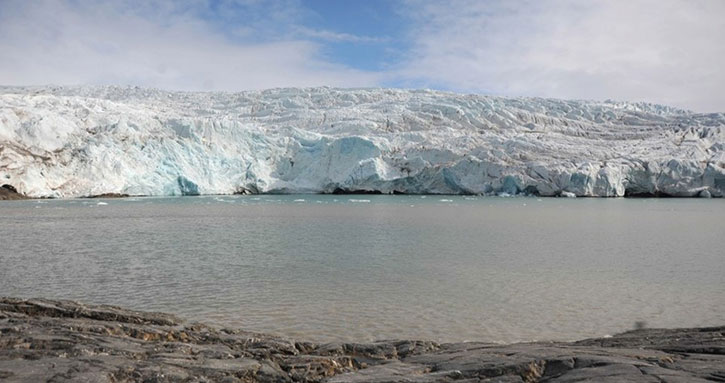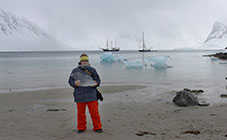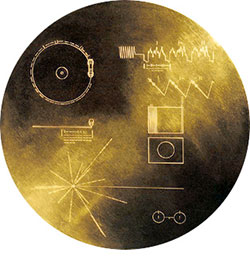Far Out: Meadows Faculty Art to Travel the Universe
Ransom, Tran works to be transmitted into deep space in 2015

Thanks to an art collaborative in St. Kilda, Australia, works by two Meadows Division of Art faculty members will be part of a collection of 44 audio and video files to be beamed into space.
Inspired by the 1977 launch of NASA’s Voyagers 1 and 2, each of which carried a “Golden Record” time capsule depicting life on Earth, the Australian Aphids collaborative decided it was time to send a 21st-century version of the Golden Record into the cosmos. Although the original Golden Record concentrated on mathematical formulas, photos, and audio recordings of music and wildlife, the contents of the new Aphid Golden Record will be entirely artistic and cultural.
In 2013, under the banner of the “Forever Now” project, the collaborative asked artists from around the world to send in 60-second audio or video files focusing on the themes of music, gender, location and/or science. Entries from 118 countries poured in; among the 44 selected for the cosmic transmission were two from Meadows faculty members Brittany Ransom and Melissa Tran.
The contents of the new Golden Record are decidedly different in presentation and in message from the original.
Melting Ice at the Top of the World
“Touching its surface and listening to its depletion was like hearing its last breath in this form.”
Assistant Professor of Digital/Hybrid Media and Video Art Brittany Ransom’s 60-second audio, Polar Glass: Glacier at Borebukta (78°25' N 014°06 E) was recorded during her Arctic Circle Research Residency in 2014. She captured the sound of a glacier slowly melting at the top of the world. At first, the dripping water sounds gentle and comforting, but the accompanying text provides a very different – and ominous – interpretation. Ransom describes her experience:

Brittany Ransom holds a fragment of glacier ice at the top of the world
“While aboard the Barkentine ship for the Arctic Circle Residency, I was fortunate enough to find myself sailing for two weeks in the presence of some of the oldest and most magnificent glaciers found in the northern hemisphere of the world,” she says. “On many days I was able to make landfall near portions of the glaciers that were receding and rapidly melting. Being in this region of the world during the summer solstice, the recession of the ice was intensified by the 24 hours of daylight and warmer-than-usual temperatures.”
In a portion of her recording, the listener can hear a thunderous roar, which is the sound of a large glacial calving. “The interspersed gentle sounds of the small pieces of ice falling into a pool like bits of glass were always broken up by much larger and alarming sounds of the glacial fronts collapsing in the distance,” says Ransom. “Conceptually, I felt this work was very referential to the conceptual ties that I have with nature, technology and the shifting of material states within both.
“For this brief moment of time, I felt as if I was able to record the last sounds of life from this piece of ice as it slowly transformed into its new fluid liquid body. Touching its surface and listening to its depletion was like hearing its last breath in this form. I felt that the Forever Now call was a great opportunity to send this audio piece as a direct representation of the shifting landscape and material depletion that are present on earth now.”
A “Private” Call
“The possibility of an unseen and infinite audience in outer space mimics the viral nature of the worldwide web …”
Adjunct Instructor Melissa Tran’s Elle Be Jay is a text-based video highlighting a 1964 phone call between U.S. President Lyndon B. Johnson and Joe Haggar of the Haggar Clothing Company. The text of the conversation dances about the screen while Johnson describes some very specific – and “colorful” – requests.

Image from Tran's text-based video "Elle Be Jay"
The piece visually highlights a long-forgotten and little-known private phone call by President Johnson, who, at the time, had thought that all such phone calls recorded in his office would not be released until 50 years after his death. However, because of the President John F. Kennedy Assassination Records Collection Act of 1992, this and other recordings were opened for research.
“In examining appropriated historical material, the archive is called to attention as a whole, especially in the context of the advancing technological world of the 20th and now 21st century,” says Tran. “Though this work was made previous to the Forever Now call, the content of the video seemed appropriate in response to speaking from this current historical moment. As communication and the spread of information have evolved with the advent of the Internet, this video serves to question boundaries of public and private spaces.
“I re-cut the work to fall under the one-minute limitation, but felt that this condensed information was fitting for the shortened attention span of the current generation. The possibility of an unseen and infinite audience in outer space mimics the viral nature of the worldwide web, wherein private happenings of public figures take root and live on.”
The trip to space
The new Forever Now Golden Record audios and videos will be sent into space in two different ways. The first will be a broadcast transmission into the cosmos during a special event in January 2015. The works will be transmitted by the Deep Space Communications Network of Cape Canaveral, Florida, which will direct the broadcast into an area of open space where there are no known satellites. The second trip into space, if all goes according to plan, will mimic the original Voyager package by placing a gold-plated Golden Record containing the artworks on board a spacecraft owned by a to-be-named private enterprise.
The collective will also hold public viewings of the recordings in various cities around the world.
Read more about SMU Meadows Division of Art, the Forever Now project and the original NASA Voyager Golden Records.
Learn more about Meadows Division of Art faculty members Brittany Ransom and Melissa Tran.
Golde Record

Photo of original NASA Golden Record
Along with scientific equipment designed to explore the universe beyond the sun, each NASA Voyager craft carries a Golden Record full of Earth’s sights and sounds. Curated by astronomer Dr. Carl Sagan and his partner Ann Druyan, the 12-inch gold-plated bronze Golden Record contains greetings in 55 different languages, scientific diagrams, photos, sound recordings of Mozart, rain and crickets, and more. The phonographic discs are packaged with a stylus in the hope that some day life forms from other planets will intercept the craft, find the Golden Record, play the disc and learn about life on Earth.
The Voyager crafts are currently over 12 billion miles from Earth and still traveling outward.